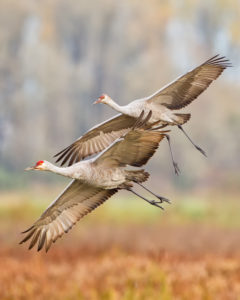Sandhilll Crane
Antigone canadensis

As we all know, the Ridgefield National Wildlife Refuge is a spectacular venue for birdwatching.
In the fall, sandhill cranes are a treasured sight and sound at the Refuge.
Our amazing Urban Refuge is located in the Pacific Flyway, one of four bird migration pathways in the U.S. In the fall months, huge flocks of sandhill cranes coming from the north migrate through the Pacific Northwest on their way to the Central Valley of California, where they spend the winter. As many as 3,000 cranes visit the refuge to rest for a while before heading south.
Sandhill cranes are magnificent-looking birds, they’re quite tall with long, slender legs, large wingspan (whoa, up to 7.5 feet!), and a large torso that tapers into a slender, long white neck. Their most striking characteristic (other than those enormous wings!) is a patch of bright crimson coloring on their foreheads. They usually weight 8-10 pounds and can be up to 4 feet tall. Their large wingspans make them very proficient soaring birds, similar to hawks and eagles.
Cranes are associated with good luck in many Native American tribes. Native fishermen in particular would consider it a good omen to spot a crane while fishing. In some Native American folklore, the crane plays the role of peacemaker. In others, the crane is notable for its vanity.
These call of these cranes is loud and blaring, and can be heard from a great distance. Mated pairs of these cranes engage in “unison calling” – standing close together and calling in a complex, synchronized duet. They can be heard up to 2.5 miles away and are given on the ground as well as in flight, when the flock may be very high and hard to see.
Sandhill cranes are omnivores, meaning they eat both plant and animal material. They’re opportunistic feeders, adapting their diet based on what food is available. They commonly forage for food in prairies, grasslands, and wetlands, and their diet mostly consists of seeds and grains, and occasionally berries, tubers, small vertebrates, and invertebrates. They don’t hunt in open water or hunch their necks the way herons do. Outside of the breeding season, they often roost in deeper water, where they are safer from predators.
Sandhill cranes mate for life, choosing their forever partner based on …. how well they dance! In the early spring, as sandhill cranes are migrating to their breeding grounds, single cranes will start pairing up. During mating, they perform dazzling dancing displays. Although they mostly dance to impress during the breeding season, some just can’t keep their feet still, and dance all year long. Sometimes the dance involves wing flapping, bowing, jumping, putting on quite the show. When the pair reaches the northern breeding grounds, they mate and build a nest.
Sandhill cranes build their nests from the dominant vegetation, such as cattails, sedges, burr reeds, bulrushes, or grasses, adding smaller stems or twigs to the base. Both mates may gather material, tossing it over their shoulders to form a mound. Their nests are large, 30-40 inches across and 4-6 inches high; nests built over water are larger than nests built on dry land.
Although the female usually lays between 1 and 3 eggs, which will incubate for approximately one month. Mated pairs and their young offspring remain together throughout the winter, then the juveniles finally head out on their own the following spring. During migration and winter the family units group together with other families and nonbreeders, forming loose roosting and feeding flocks, as large as tens of thousands. Eggs, nestlings, and injured or sick adults may be hunted by foxes, raccoons, coyotes, wolves, bobcats, crows, ravens, eagles, and owls. Cranes attack aerial predators by leaping into the air and kicking their feet forward. They threaten terrestrial predators by spreading their wings and hissing, eventually resorting to kicking.
COOL FACTS: Sandhill cranes can live up to 20 years or more! In the wild, they have a greater chance of dying young.
The earliest sandhill crane fossil, estimated to be 2.5 million years old, was excavated in the Macasphalt Shell Pit in Florida.
Sandhill cranes are known for their impressive dancing skills, stretching their wings, pumping their heads, bowing, and leaping into the air in a graceful and energetic dance.
The oldest sandhill crane on record was at least 36 years, 7 months old. Originally banded in Wyoming in 1973, it was found in New Mexico in 2010.
Note: *The Refuge’s “Bird of the Year” is a turkey vulture! To learn more about these amazing creatures, please visit https://ridgefieldfriends.org/events/birdfest-bluegrass/
Photo Credit: Dennis Davenport Adult 2nd Place 2016 Refuge Photo Contest Winner